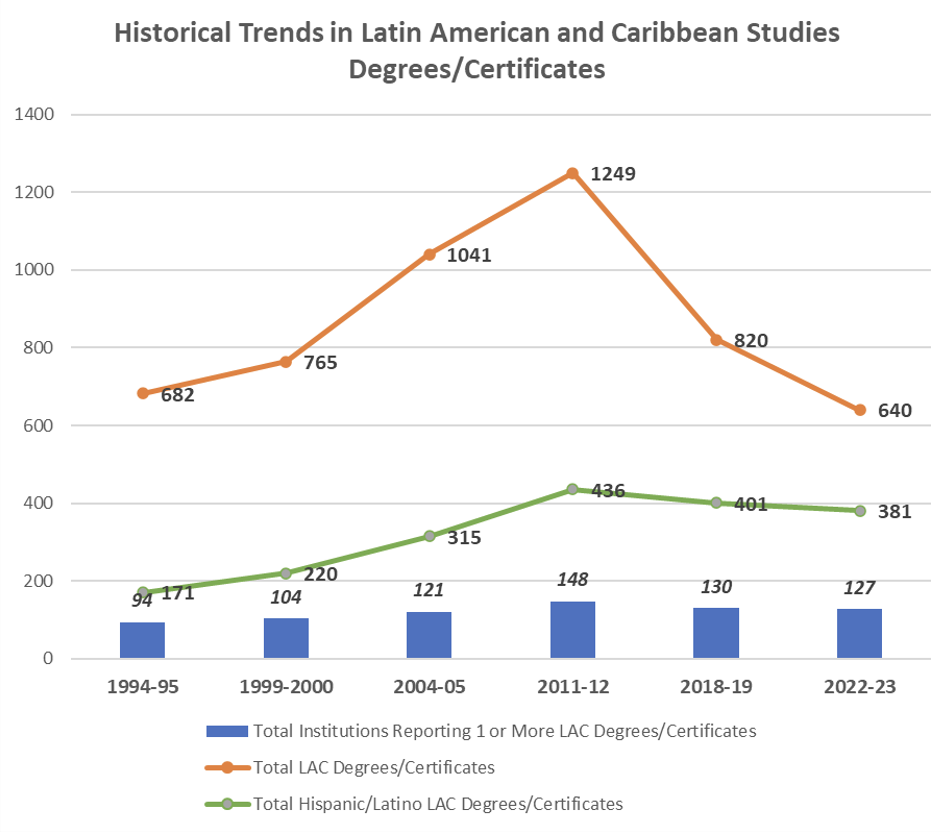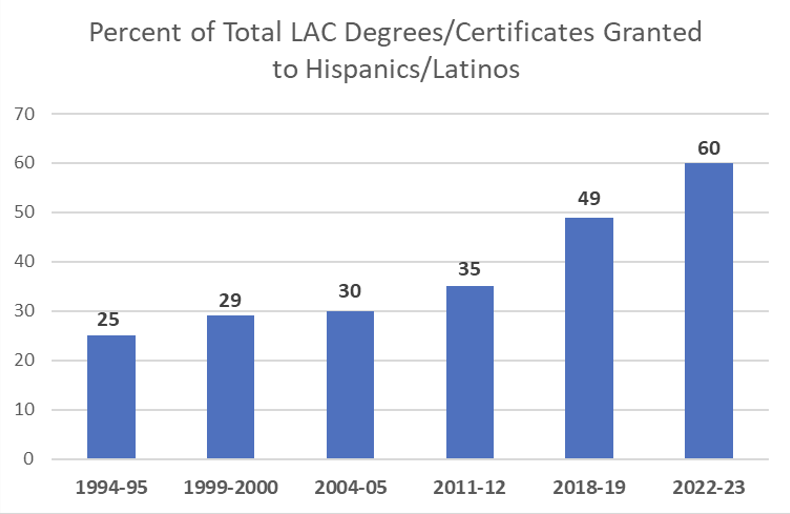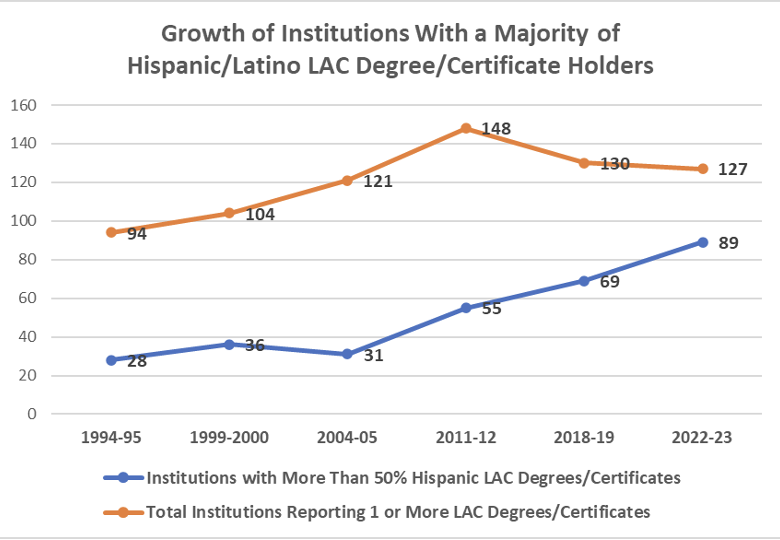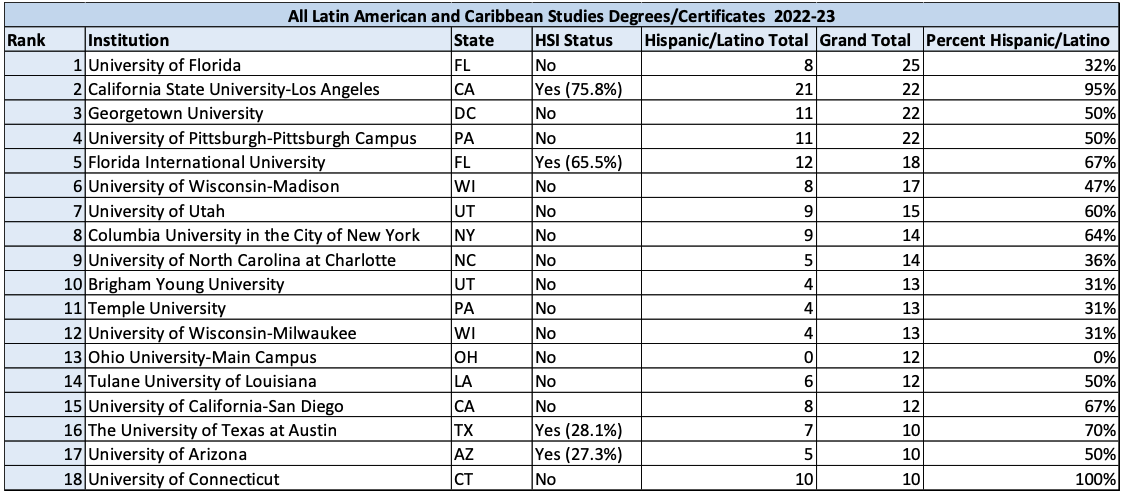The field of Latin American and Caribbean Studies has a long history in U.S. higher education, and today there are hundreds of programs, centers and specialized courses of study dedicated to this region across the country. They are important sites for learning about the region through a variety of means which generally include student and scholar exchanges, study abroad experiences, international seminars and cooperative research programs on regional issues, venues for hosting cultural events and showcasing the arts, music, language and literature of these countries, and – in many cases – for discussing issues related to the U.S. Hispanic/Latino community as well. Indeed, there are a plethora of Mexican-American, Chicano or Latino Studies programs across the country that are dedicated specifically to the Hispanic/Latino community, which will be profiled separately in the next part of this series, followed by a profile of Spanish and Portuguese Language programs. All three parts of this series will include data on the participation of Hispanic/Latino students, in order to obtain a broader picture of the ways in which Hispanics/Latinos are taking the opportunity to expand knowledge of their roots as “heritage learners” in higher education.
Data on Latin American and Caribbean Studies: Defining Specific Parameters
Students wishing to gain a deeper understanding of Latin America and the Caribbean (LAC) have a wide variety of options: they can join a specific LAC Program or Institute, leading to an AS, BA, MA or PhD degree, or a Certificate of Studies; take part in a joint LAC and Latino/Hispanic/Chicano Studies Program, or a joint LAC and Spanish Language Program (both of which are common); or join a different program (Political Science, International Relations, Ethnic Studies, Interdisciplinary Studies, etc.) that includes a LAC undergraduate major or minor, or a graduate level LAC specialized concentration.
It is challenging to disentangle these myriads of pathways to obtain accurate data specifically on Latin American and Caribbean Studies in U.S. higher education. In order to get as clear a picture as possible, this profile is based on federal data from the NCES Integrated Postsecondary Education Data System (IPEDS) for multiple years, including the most recent year available (the 2022-23 academic year).
Specific IPEDS Classification of Instructional Programs (CIP) Codes were used to narrow the parameters of the field. Within the IPEDS Area Studies category (CIP Code 5.01), the descriptors Latin American Studies (CIP Code 5.0107), Caribbean Studies (CIP Code 5.0119) and Latin American and Caribbean Studies (CIP Code 5.0134) were selected. For each of these sub-categories of study, there is data on the number of degrees and certificates granted, which includes all levels of study (from one-year certificates to full doctoral degrees), and both first and second majors. The data for these three sub-categories was combined, to give a total number of all degrees and certificates granted in Latin American and/or Caribbean (LAC) Studies.
It must be noted that there are bound to be gaps in this data, given that it does not include:
-Degrees or certificates from institutions that have specific LAC studies programs, but may have chosen to report them to IPEDS under different, broader CIP codes (such as 5.99, Ethnic, Area, Cultural, Gender, Group Studies and Other, for example, among many others).
-Degrees or certificates from programs that combine LAC with Hispanic/Latino/ Mexican-American and Chicano Studies (which are reported under the broader Ethnic Studies category), and Spanish/Portuguese Language Studies (reported under the broader Foreign Languages category.
-Degrees or certificates from programs that combine LAC with other fields (International Relations, Political Science, etc.), which report data to IPEDS under these entirely different categories
- Students who have undertaken LAC studies, but declared them as minors or specialized concentrations within degrees in other fields
- Institutions that offer LAC studies but did not grant any degrees or certificates in the specific year reported to IPEDS, particularly if they are primarily dedicated to higher-level research
Evolution of LAC Degrees and Certificates Over the Past Three Decades (1994-95 to 2022-23)
Overall Trends – Rise and Decline
Our analysis of IPEDS historical data for six intervals of academic years between 1994-95 and 2022-23 shows that until 2011-12, there was a steady increase in the number of institutions reporting one or more LAC degrees/certificates, and in the total number of these degrees/certificates; however, the years 2018-19 and the most recent data, for 2022-23, show a decline in these numbers. While slow recovery after the Covid19 pandemic may account for the 2022-23 reduction, it does not account for the fact that these numbers were already in decline in 2018-19, before the pandemic. Indeed, the number of institutions reporting one or more LAC degrees/certificates in 2022-23 was nearly the same as it was almost two decades ago (in 2004-05), and the total number of LAC degrees/certificates awarded has reduced to less than what it was almost thirty years ago (in 1994-95).

More research is needed to understand the reasons behind this notable decline in the number of reported LAC degrees/certificates, and whether these are related merely to reporting issues (institutions changing the ways in which they define LAC programs, for example), or to a decline in interest or funding for the field of Latin American and Caribbean Studies itself.
The top LAC degree/certificate-granting institutions had much larger numbers thirty years ago; these have been dwindling fairly steadily over the years, and the current top institutions granted less than 30 LAC degrees/certificates each (in 2022-23). Although some institutions (such as UT Austin and the University of Pittsburgh) retained their dominance in this area over many years, there has been a constant rotation of institutions that have occupied the top ranks in terms of reported numbers of degrees/certificates.

Growth of Hispanic/Latino “Heritage Learners” in LAC Studies
IPEDS data shows that the number of LAC degrees/certificates conferred to Hispanic/Latino students has also increased and then dipped over the past three decades; however, the decrease over the past years since 2011-12 has not been as drastic as that of the overall number of LAC degrees/certificates. Indeed, over the past 28 years, the total number of LAC degrees/certificates granted to Hispanics/Latinos has more than doubled, from 171 in 1994-95 to 381 in 2022-23 (see graph above).
At the same time, the proportion of LAC degrees/certificates granted to Hispanic/Latino students has increased dramatically, from only 25% of the total in 1994-95 to 60% of the total in 2022-23.

Likewise, the number of institutions where more than 50% of LAC degree/certificate recipients are Hispanic/Latino has also grown substantially – indeed, these majority Hispanic/Latino-recipient institutions now represent 70% of all institutions reporting LAC degrees/certificates, whereas they only represented 30% in 1994-95.

This historical data can be seen as part of a positive trend of greater enrolment and degree attainment of Hispanics/Latinos in higher education overall; it can also indicate the welcome development of greater interest among Hispanic/Latino students in valuing their roots and understanding these better. At the same time however, further research is needed to ascertain whether these numbers might also signal decreasing interest in LAC studies on the part of other ethnic groups, or indicate a wider trend wherein members of each ethnic group retreat into their own cultural silos rather than venturing to learn more about others.
Institutions with the largest numbers of LAC degrees/certificates conferred to Hispanic/Latino students have varied over the years, although some -namely, UCLA and UT Austin – have remained fairly constant.

The Current Scenario: Top LAC Degree/Certificate-Granting Institutions
The following list includes all institutions that reported more than 10 LAC degrees/certificates in the 2022-23 academic year:

All are 4-year schools, and the majority are public (78%)
-They are widely spread out across the country (in 13 states), rather than being concentrated in any single state or region
-More than half (10) are Federally-designated Title VI National Resource Centers (NRC) for Latin America, making them eligible for grants to support scholarships, teaching and research
-Only four are HSIs, yet most of these institutions (11) have a large proportion of Hispanic/Latino LAC degree/certificate recipients (more than half of all LAC degree/certificate recipients).